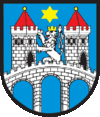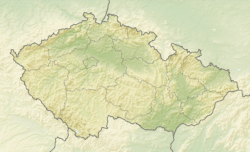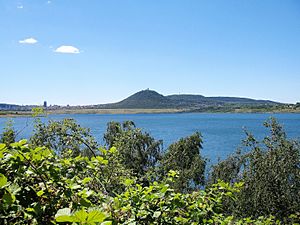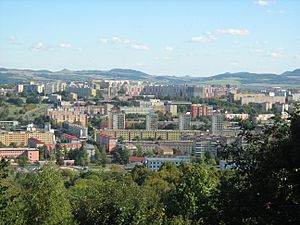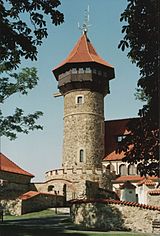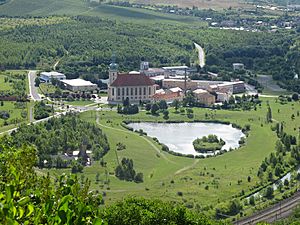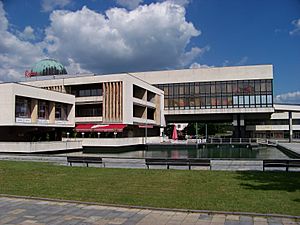Most (city) facts for kids
Quick facts for kids
Most
|
|||
|---|---|---|---|
|
Statutory city
|
|||
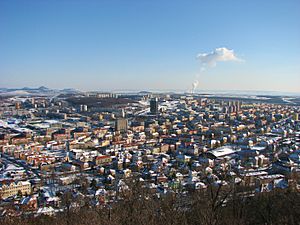
View of the city from Hněvín Castle
|
|||
|
|||
| Country | |||
| Region | Ústí nad Labem | ||
| District | Most | ||
| First mentioned | 1040 | ||
| Area | |||
| • Total | 86.94 km2 (33.57 sq mi) | ||
| Elevation | 233 m (764 ft) | ||
| Population
(2024-01-01)
|
|||
| • Total | 63,882 | ||
| • Density | 734.78/km2 (1,903.08/sq mi) | ||
| Time zone | UTC+1 (CET) | ||
| • Summer (DST) | UTC+2 (CEST) | ||
| Postal code |
434 01
|
||
Most (Czech pronunciation: [most]; German: Brüx) is a city in the Ústí nad Labem Region of the Czech Republic. It has about 64,000 people living there.
Most is known as an industrial city. It has a long history of mining for a type of coal called lignite. Because of this mining, the old historic city was taken down. A new, planned city was built in its place. Where mining has finished, Most is a great example of how land can be successfully brought back to life.
Contents
City Parts and Villages
Most is made up of eight main parts. These include the city center of Most itself. It also includes the villages of Starý Most, Čepirohy, Komořany, Rudolice, Souš, Velebudice, and Vtelno.
What's in a Name?
The name Most means 'bridge' in the Czech language. This name first appeared as a translation of its German name, "Brüx." That German name came from the word Brücke, which also means 'bridge'. The city got its name because of the many bridges that crossed the swampy areas here in the 10th century.
Most's Location and Landscape
Most is located about 33 kilometers (20 miles) southwest of Ústí nad Labem. It is also about 70 kilometers (43 miles) northwest of Prague. The city sits where the Most Basin meets the Central Bohemian Uplands. The highest point nearby is Ressl Hill, which is 413 meters (1,355 feet) above sea level. The Bílina River flows right through the city.
There are also several artificial lakes here. These lakes were made during land rehabilitation after coal mining stopped. The biggest one is Most Lake, created between 2008 and 2012. It covers an area of 309.4 hectares (764.5 acres). This makes it the second-largest artificial lake in the Czech Republic. People mostly use it for sports and fun activities. Another important lake in the center of Most is Matylda Lake. It is also used for sports and recreation. This lake was filled in 1992 and covers 38.7 hectares (95.6 acres).
Most's Past: A Journey Through Time
Early Days (11th–15th Centuries)
The first time Most was mentioned in writing was in 1040. It was called Gnevin Pons, meaning "Hněvín Bridge." Around the late 1100s, the Hrabišic family started to settle the area. They built a strong fort here. Most began as a market village where old trade routes crossed. After 1210, the village moved to the other side of the Bílina River.
In 1227, the last Hrabišic, Kojata, gave his land to a monastery. But King Wenceslaus I took Most back. Hněvín Castle was built where the old fort stood, from 1238 to 1248. After 1240, Most started to look like a town. It was first called a town in 1247. By the mid-1200s, it became a royal city. King Ottokar II gave the city even more special rights in 1273. The city grew quickly because it was in a good spot near the country's borders and on an important road.
The city kept growing under later kings. However, fires damaged the city in 1321, 1334, 1395, and 1455. In 1374, Charles IV gave Most the right to have vineyards. Wine had probably been made here since the 1100s. By the mid-1300s, the city walls were finished. The good times ended with the Hussite Wars. But the city held strong against the Hussite attacks in both 1421 and 1424. Most recovered thanks to its important trade route and the start of iron mining nearby.
Later Centuries (16th–17th Centuries)
In 1515, the worst fire in Most's history happened. It damaged the church from 1253–1257 and the town hall. Building a new church started in 1517. A new Renaissance-style city hall was built before 1553. In the late 1500s, times got harder. There were bad harvests, money owed to the king, sickness, hunger, more fires, and wars. Most went into debt and spent the next hundred years paying it off. In 1595, the city bought Hněvín Castle and other lands from Emperor Rudolf II.
From 1639 to 1648, during the Thirty Years' War, the city was taken over by Swedish troops. This was because of Hněvín Castle. After the war, the city lost much of its importance. To stop the castle from being a reason for future attacks, the people of Most asked Emperor Ferdinand III to tear it down. The castle was taken down between 1651 and 1653.
Modern Era (18th–19th Centuries)
Huge amounts of coal were found in the 1700s. Most was affected by the Silesian Wars, having to pay money for the war. After the city's money situation got better in the late 1700s, Most was affected again. This time it was by Napoleon's army passing through in the early 1800s. In the first half of the 1800s, the old medieval walls were taken down. In 1820, another big fire hit Most.
At the start of the 1800s, mining for lignite coal began. Industries started to grow. A big change came with the railway built in 1870. This connected Most to places where coal could be sold. The last part of the 1800s saw a fast increase in people living there. Many new homes were built, and more Czech people moved in. A sugar factory, a porcelain factory, a steel factory, a brewery, and a city museum were all built.
The 20th Century and Beyond
In 1938, Most became part of Germany. During World War II, from 1938 to 1945, the city was under German control. People were made to work in difficult conditions in coal mines outside Most. These workers were mostly from Poland. Most was bombed many times during the war. A prison was also located in the city.
After the war, Most became part of Czechoslovakia again. Many German residents moved away, and Czech people moved in.
In 1964, the government decided to demolish the historic city of Most. This was to make way for more coal mining. The old Gothic city center, a brewery from 1470, a theater from 1910, and a cemetery from 1853 were all destroyed. Only the Church of the Assumption of the Virgin Mary was saved. The destruction of the old city began in 1965 and finished in 1985. At the same time, a new city started to be built. The first new building was finished in 1971. The new buildings were mostly large apartment blocks called paneláks. They followed a style of architecture common at that time. The destruction of Most brought a lot of money to the state because of the coal mined there.
Building the new City Hall started in 1972 and finished in 1977.
The Ležáky coal mine, where the historic Most once stood, closed in 1999. Most Lake was created there by filling the old mine with water from the Ohře River. It opened to the public in 2020.
Most's People
Most has a notable Romani people community. Many of them live in the Chanov housing estate.
| Historical population | ||||||||||||||||||||||||||||||||||||||||||||||||||||||||
|---|---|---|---|---|---|---|---|---|---|---|---|---|---|---|---|---|---|---|---|---|---|---|---|---|---|---|---|---|---|---|---|---|---|---|---|---|---|---|---|---|---|---|---|---|---|---|---|---|---|---|---|---|---|---|---|---|
|
|
|
||||||||||||||||||||||||||||||||||||||||||||||||||||||
| Source: Censuses | ||||||||||||||||||||||||||||||||||||||||||||||||||||||||
Most's Economy
Most is on the edge of the Most Basin. This area is very important for mining lignite coal. Since large amounts of coal were found, mining has greatly shaped the city. It brought many new residents and helped other industries grow. But it also led to the destruction of the city's historic parts. The mining industry still provides jobs for hundreds of people. The biggest employer in the city is Czech Coal Group.
The Komořany power plant is connected to coal mining. It is a large power plant that uses lignite coal. It was built between 1955 and 1958.
Besides mining, Most also had heavy industry and chemical factories. But in the 21st century, services are becoming more important to the city's economy. Mining continues, not just for coal, but also for bringing the land back to life. Growing wine and fruit has also started again. The way the land around Most has been brought back to life is special. It is seen as a great example of how to restore landscapes. The areas outside Most have also become popular for tourism.
Getting Around Most
Most is located on several railway lines. These include lines connecting to Prague, Cheb, Kadaň, Děčín, and Rakovník. Besides the main railway station, there are also stops at Most-Kopisty and Třebušice.
The city shares a transport company with the nearby town of Litvínov. In addition to buses, there is also a tram network that connects Most and Litvínov.
Culture in Most
The Repre House of Culture started being built in 1972. It was finally finished on June 2, 1984. It has a planetarium on its roof, a cinema, and many other rooms and halls. The city sold the building in 2010. There have been many ideas for how to change or fix it since then.
A new theater was planned for the new city center in the late 1960s. But building didn't start until 1979. It opened on November 7, 1985. It was designed by Ivo Klimeš. It has a main hall with 500 seats. Until 1990, it was called the "Theatre of the Working People."
Learning in Most
Three universities have special locations in Most. These are the Czech University of Life Sciences Prague, VSB – Technical University of Ostrava, and the University of Finance and Administration.
Sports in Most
The local football club, FK Baník Most 1909, existed for over 100 years. It used to play in the top football league in the Czech Republic. However, it closed down in 2016. Now, the city is represented by FK Baník Most-Souš. This team plays in the third tier of Czech football.
Most Hippodrome is located in the Velebudice part of Most. The city hosts eight horse racing days each year. This makes it one of the main horse racing places in the region. The area with the race track was created by bringing the land back to life. It is also used for other sports and cultural events.
Most is famous for Autodrom Most. This is a race track for motorsports that opened in 1983.
Aquadrom Most is a water park located in the center of Most.
Places to See in Most
Hněvín Castle is one of the city's main sights. The original castle was torn down in 1651–1653. The current romantic castle was built as a copy of it. Its main part is a stone lookout tower, built in 1900.
The most important old building is the Gothic Church of the Assumption of the Virgin Mary. It was built from 1517 to 1602. This happened after the old city church was destroyed by a huge fire in 1515. The church became famous when it was moved 841.1 meters (2,759 feet) to the new city in 1975. This was done because the historic center of the old town was being demolished. The move took 28 days. It moved at an average speed of 2.16 centimeters (0.85 inches) per minute. The government was very proud of moving this church. The building was even mentioned in the Golden Guinness Book Of World Records. It was listed as the heaviest building ever moved on wheels.
The oldest building still standing in Most is the Church of the Holy Spirit. It was probably built in the 1320s. It was first mentioned in records in 1351. The church is small, but it is very special because it is so well preserved. It is also a pure example of Gothic style. After the Church of the Assumption of the Virgin Mary was moved, the two churches ended up next to each other. Today, the Church of the Holy Spirit is no longer used for religious services. Instead, it hosts art exhibitions and classical music concerts.
In Vtelno, you can find the Church of the Exaltation of the Holy Cross. It was built in the Baroque style between 1736 and 1738.
Other interesting places include the Regional Museum in Most. There is also a Neorenaissance fountain and a plague column. This column has sculptures of St. Anne. You can also see a set of Stations of the Cross and a Jewish cemetery in Souš.
Famous People from Most
- Andreas Hammerschmidt (about 1611–1675), a composer
- Florian Leopold Gassmann (1729–1774), a composer
- Rudolf Ritter (1878–1966), a singer (tenor)
- Wenzel Hablik (1881–1934), a painter and architect
- Raoul Schránil (1910–1998), an actor
- Heini Halberstam (1926–2014), a mathematician
- Judita Čeřovská (1929–2001), a singer
- Josef Masopust (1931–2015), a famous football player and coach
- Olga Fikotová (1932–2024), a Czech-American discus thrower and Olympic winner
- Jan Mühlstein (born 1949), a politician
- Pavel Chaloupka (born 1959), a football player
- Vladimír Růžička (born 1963), an ice hockey player
- Libor Pimek (born 1963), a tennis player
- Petr Svoboda (born 1966), an ice hockey player
- Bedrich Benes (born 1967), a computer scientist
- Martin Ručinský (born 1971), an ice hockey player
- Jan Vopat (born 1973), an ice hockey player
- Petr Franěk (born 1975), an ice hockey player
- Vlastimil Kroupa (born 1975), an ice hockey player
- Petr Johana (born 1976), a football player
- Marek Židlický (born 1977), an ice hockey player
- Pavel Rosa (born 1977), an ice hockey player
- Kamil Piroš (born 1978), an ice hockey player
- Tomáš Divíšek (born 1979), an ice hockey player
- Markéta Jánská (born 1981), a model
- Tomáš Kůrka (born 1981), an ice hockey player
- Iveta Benešová (born 1983), a tennis player
- Lukáš Kašpar (born 1985), an ice hockey player
Most's Sister Cities
Most has special partnerships with other cities, called twin towns:
Images for kids
-
Tomáš Garrigue Masaryk statue



